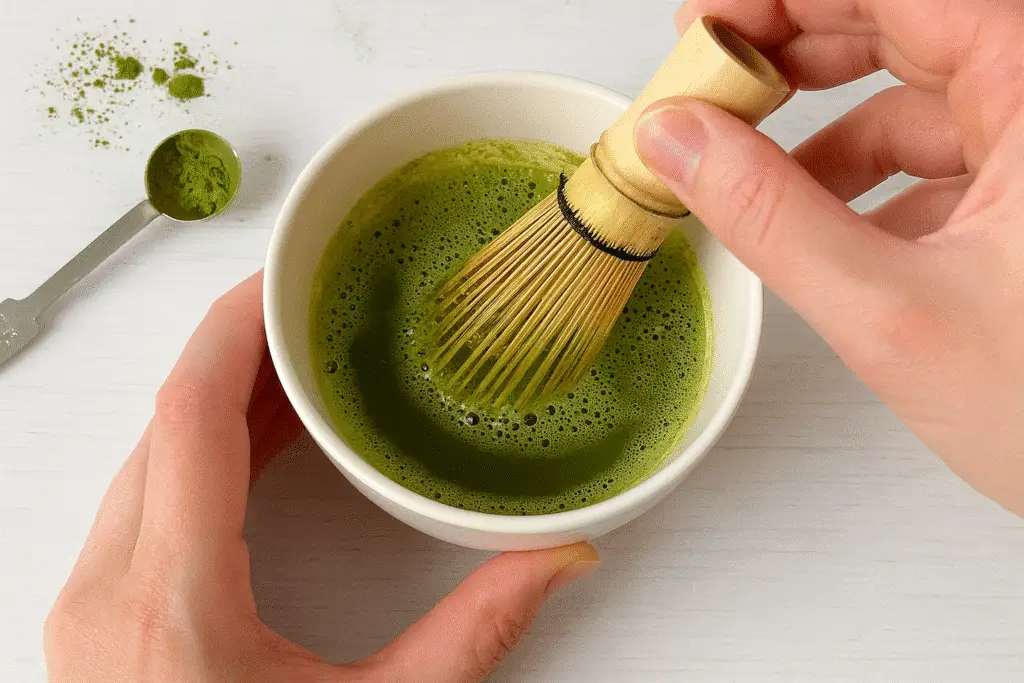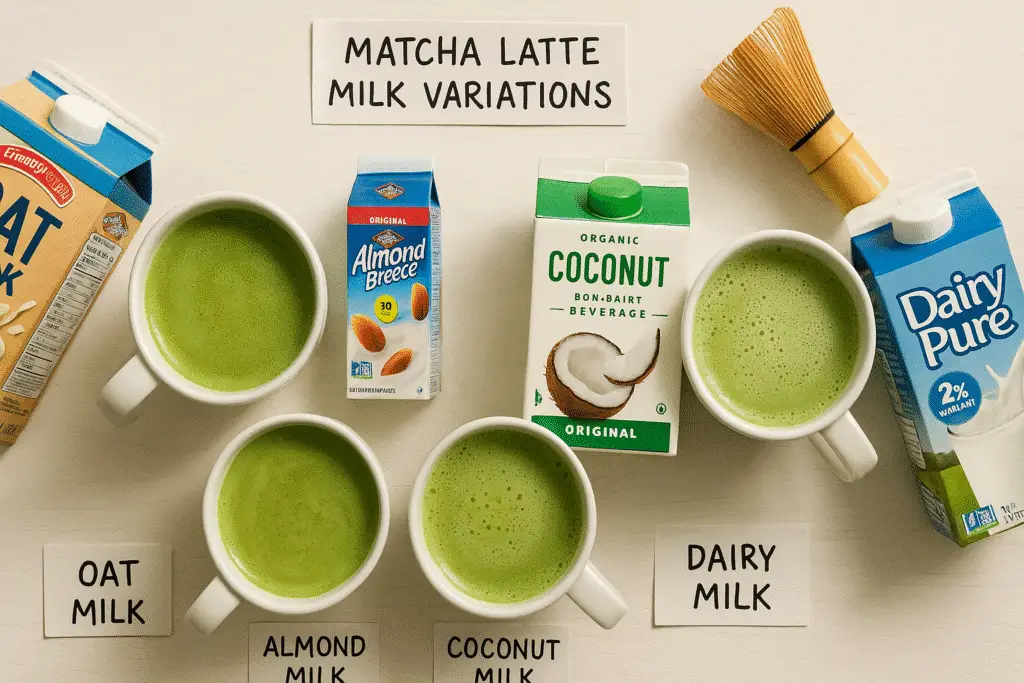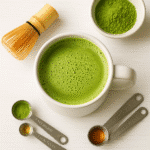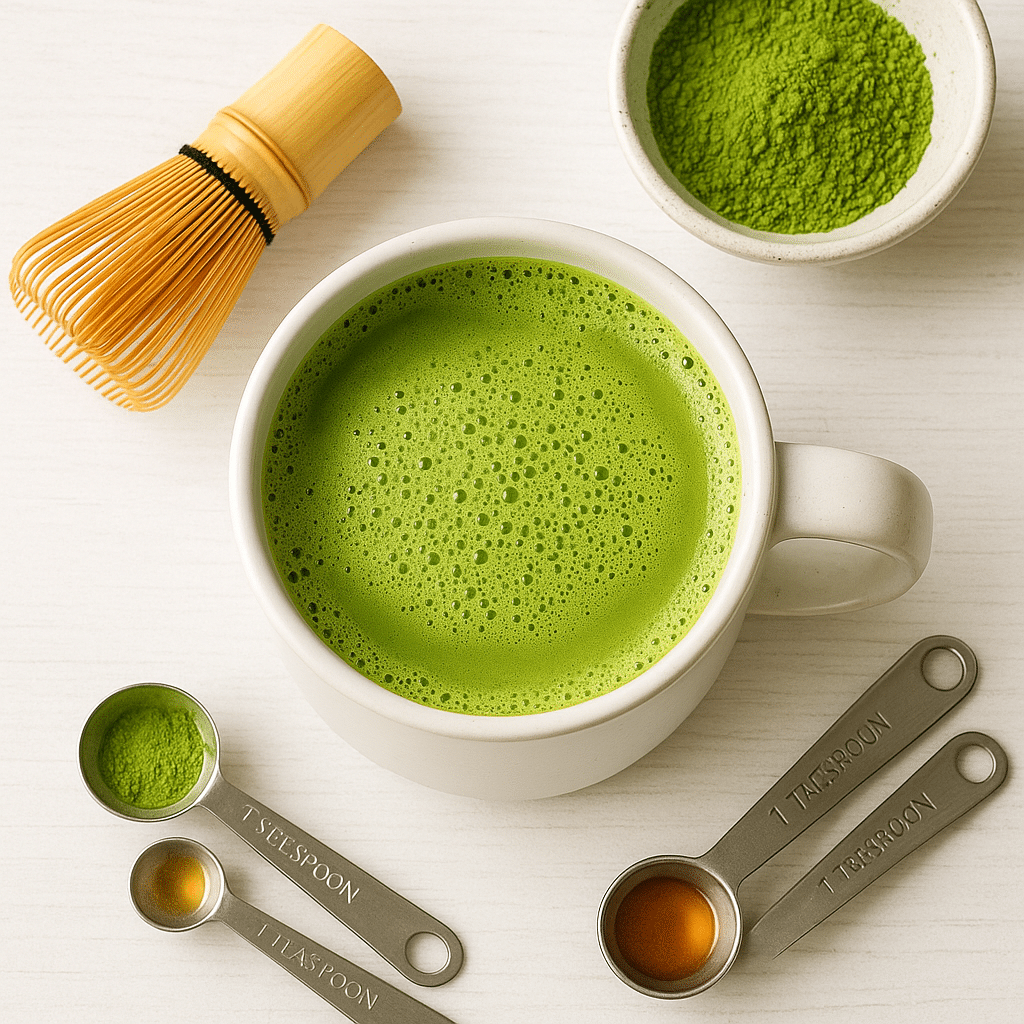I’m Emma in Asheville — and this matcha latte recipe is my calm-in-a-cup when the house is loud and nap time finally hits. I make it fast at home, no fuss, no special tools. It’s my little reset between school drop-off and the afternoon scramble.
I reach for this drink because I can’t handle a coffee crash. It’s creamy, bright, and smooth. The taste wakes me up gently, never jittery.
Here’s the deal: simple steps, basic tools, forgiving results. I keep the cup-to-cup flow tidy — hot water, a splash of milk, a minute of whisking — and you’re done. I’ll show tweaks for warm or iced versions and a few tricks to keep sweetness subtle.
Beginners, breathe easy: this routine fits into busy-parent life. If there’s a spill, I stir and keep going. Joy over perfection — that’s my motto.
Table of Contents
Key Takeaways
- This matcha latte recipe is quick and kid-friendly for busy homes.
- Short steps and simple tools make it easy for beginners.
- The drink delivers steady energy without a coffee crash.
- Tweak milk and sweetener to match your taste.
- Hot or iced, this routine is repeatable and forgiving.
My Cozy Matcha Latte Recipe Story at Home
Around three, I trade chaos for a quiet cup and thirty seconds of calm. The toddler nap window is sacred. I need fast comfort that keeps me steady — not wired like a late-night coffee fix.
Why this became my afternoon ritual
It began as an experiment during a busy season. One soft sip made it a habit. The drink felt focused and gentle. I kept reaching for it day after day.
The nap window: quick, creamy, calm energy
I can make a warm latte in minutes. Or switch to iced matcha when the sun turns the kitchen into a sauna. One hand on the kettle, one hand steadying blocks — it’s that simple.
- Whisk-and-breathe: thirty seconds to foam, then sip and reset.
- Less sweet on weekdays. Tiny drizzle on Fridays. Extra creamy when I need comfort.
- This small cup changes the vibe at home — quiet, green, a little frothy — and gives me just enough lift to finish the day with a smile.

What Is Matcha? The Green Tea Leaves Behind the Latte
One small scoop changed how I think about green tea in my daily cup. I drink the whole leaf here — not just a brewed pour-off. The powder is finely ground from shade-grown green tea leaves, so that bright color means more chlorophyll and a stronger taste.
Matcha vs brewed green tea
With brewed green tea, you steep and discard the leaves. With this powdered tea, you whisk the whole leaf into water or milk. That swap gives you higher levels of antioxidants — often many times a regular cup.
Grades, color, and picking quality
- Ceremonial grade looks vivid and tastes smoother — great for sipping plain.
- Culinary or lower grade matcha can be duller and more bitter — fine for baking or mixes.
- If the powder is gray-green and harsh, save it for cookies, not your cozy drink.
“A little ground tea goes a long way — start small and adjust by feel.”
Quick tip: whisk with hot, not boiling, water to avoid scorchy bitterness. If you want more background on the powder, see matcha for history and growing notes.
Ingredients and Tools I Actually Use
I keep a tiny shelf of essentials so I can pull together a cup in under two minutes. Fresh matcha powder, hot water just off the boil, and the milk I’m in the mood for are my core ingredients.
I rotate oat milk for creaminess, almond milk when I want light nuttiness, and coconut or dairy for richer sips. A small whisk or a frother gives quick foam. A wide bowl helps beat clumps fast.
- A gentle drizzle of maple or simple syrup is my usual sweetener.
- For iced: 2 tsp powder, 1–2 tbsp hot water to make a paste, then 1 cup water; chill, pour over ice, add milk of choice.
- For hot: sift the powder, whisk with steaming (not boiling) water up-and-down until frothy, then add warmed milk.
“Keep gear minimal. Good ingredients and a steady wrist beat fancy tools every time.”
| Item | Why I Use It | Best For | Notes |
|---|---|---|---|
| Matcha powder | Bright flavor | Sipping plain or with milk | Sift first to avoid clumps |
| Whisk / frother | Foam and smoothness | Hot or iced drinks | Bamboo whisk for ritual; frother for speed |
| Oat / Almond / Coconut milk | Texture and taste | Oat for cream, almond for light | Rotate by mood |
| Small bowl | Room to whisk | Mixing paste | Wide rim prevents spills |
Hot Matcha Latte: Step-by-Step, The Cozy Way
A short, frothy cup is my go-to when the day crowds in. I keep steps simple so you can make a warm drink fast. Follow these friendly instructions and tweak as you like.
Sift, whisk with hot (not boiling) water, then add warmed milk
- Sift 1/2–1 teaspoon matcha powder into a small bowl or mug so the surface is smooth and clump-free.
- Add 1/4 cup hot water — recently boiled but not boiling — and whisk up-and-down for about 30 seconds until foamy.
- Then warm 1/4–3/4 cup milk (oat, almond, or coconut) and pour it in slowly while whisking to combine.
How I sweeten and adjust the amount for my perfect cup
If you want sweetness, add a small swirl of maple syrup, taste, and adjust. Next, check the amount of liquid in your cup. Top with a splash of water or extra milk to hit the strength you love.
- For thicker foam, whisk in short, fast bursts.
- For a smoother sip, use Golde Pure Matcha Ceremonial Grade for gentle flavor.
- Write down your favorite ratio — then make it your weekday default.

“Sift, whisk, warm, pour, taste, tweak — that rhythm makes a cozy cup every time.”
| Step | What to Do | Why it Helps |
|---|---|---|
| 1 | Sift powder | Prevents clumps and gives even whisking |
| 2 | Whisk with hot water | Builds foam and blooms the flavor |
| 3 | Warm and add milk | Controls creaminess and texture |
| 4 | Sweeten lightly | Tames earthiness without hiding it |
Iced Matcha Latte: Cold, Creamy, and Ready in Minutes
I keep a quick cold version on standby for hot afternoons and short nap windows. It’s fast, forgiving, and tastes like a tiny treat without the fuss.
Whisk into a smooth paste, then dilute and chill. Start by sifting 1 teaspoon matcha powder into a bowl. Add 1–2 tablespoons recently boiled (not boiling) water and whisk into a dark, smooth paste.
- Add up to 1 cup water to thin the paste, whisk until bright and lump-free, then pop it in the fridge for about 15 minutes while you grab ice.
- Fill a tall cup with lots of small ice cubes to keep the chill without watering it down quickly.
- Pour the chilled matcha over the ice, top with your milk of choice, and enjoy that green swirl before you stir.
If you want sweetness, add a small spoon of syrup—maple or simple works great—and stir. On rushed days, skip chilling: blend the paste with cold milk and a few ice cubes for a silky drink in seconds.
Pro tip: If clumps appear, blitz briefly with a hand frother or a 10-second blender spin. Keep a jar of chilled base in the fridge for an even faster pour-and-top cup when the heat hits.

Milk and Sweetener Options That Change the Game
Pick the milk you love and the whole drink changes — seriously. Small swaps shift texture, foam, and the final taste. I keep the choices simple so mornings stay calm.
Oat, almond, coconut, or dairy: quick pros and cons
Oat milk gives a creamy, barista-style texture and holds foam well. I use it when I want a silky cup that feels indulgent.
Almond milk stays light with a gentle nutty note. It lets the green powder lead and keeps the cup bright.
Coconut milk brings richness and a hint of coconut — perfect for cozy mugs on rainy afternoons. Dairy milk is classic: reliable foam and a balanced body that many folks prefer if they drink coffee daily.
| Milk | Best for | Notes |
|---|---|---|
| Oat | Creamy iced cups, foam | Barista texture, great for matcha lattes |
| Almond | Light, nutty sips | Keeps the powder’s flavor forward |
| Coconut | Rich, cozy mugs | Pairs nicely with sweet spices |
| Dairy | Classic foam and warmth | Familiar comfort and sturdier foam |
Sweetener choices: how to tame earthy notes
I aim for a small hit of sweetener. That keeps the cup balanced without masking flavor. Start with a drizzle — you can always add more.
- Maple syrup adds warmth and depth.
- Simple syrup blends evenly, so it’s my go-to for cold cups.
- Stevia works when I want zero calories and fast sweetness.
- Other options: agave or coconut sugar for different textures.
“Start tiny. Taste. Then decide if you want more.”

I keep two milks in the fridge so I can switch by mood. If you mostly drink coffee, try a creamier milk first — it bridges the texture gap. For more tips, see my quick tips.
Common Mistakes and My Time-Saving Tips
Little mistakes used to ruin my afternoons—now I fix them in seconds. These are quick, practical fixes I use when I’m short on time. They keep the color bright and the mouthfeel smooth.
Don’t use boiling water. Use hot water that’s just off the boil. It protects the green color and keeps the taste clean.
Clumps and weak foam
If you see clumps, sift the powder into a bowl first. It takes seconds and saves the whole cup from grainy sips.
Whisk up-and-down, not just in circles. That motion traps air fast and builds foam. No whisk? Use a frother or blender — under a minute for café-level texture.
Make-ahead base and ice choices
For an iced matcha latte, mix a small base and chill it about 15 minutes. When it’s go-time, pour over ice and top with milk for instant refreshment.
Use smaller ice cubes so the drink chills without diluting too fast. Big cubes melt slower but can be clunky in a home cup.
- If the cup is too strong, add a splash of water. Too light? Whisk in a touch more base.
- Choose quality matcha when you can—better color and flavor means less sweetener and fewer fixes.
- Short on time? Pre-measure single-serve packets so you can whisk and sip without hunting for scoops.
“Small habits—sifting, the right water temp, and a quick whisk—turn mistakes into quick wins.”
| Problem | Quick Fix | Why it Works | Time |
|---|---|---|---|
| Burnt or bitter taste | Use hot, not boiling water | Preserves color and flavor | Under 1 minute |
| Grainy texture | Sift into a bowl before whisking | Removes clumps for smooth sip | 10–20 seconds |
| Flat foam | Whisk up-and-down or use frother | Traps air quickly for froth | 20–40 seconds |
| Watery iced cup | Chill base; use small ice cubes | Less dilution, faster pour-and-go | 15 minutes chill; ready fast |
Variations, Serving Ideas, and Handy Links
Small swaps make a big splash — here are simple ways I dress up a basic cup. These ideas are fast, playful, and kind to a busy kitchen.
Iced, strawberry, and lavender twists
For a classic cold version: whisk the base, pour it over ice, top with milk, and stir. This iced matcha method stays bright and refreshing.
Strawberry iced matcha: blend 1/3 cup strawberries with 1 tsp sugar. Pour that into your glass, add cold milk, then finish with the whisked green tea powder for a pretty layered look.
Lavender vibe: add 1 tablespoon lavender syrup into your paste while whisking. It smells fancy and takes almost no extra time.
- I lean oat for creamy sweetness or almond milk for a lighter, nutty note — both let the green shine.
- If you host, pre-whisk a base in a matcha bowl and set out toppings: maple drizzle, vanilla, or citrus peel.
- Pair sips with quick treats — warm cookie mugs or a brownie in a cup. See my mug recipes at BusyCookLife.com for fast ideas.
- For honey lovers, check matcha and honey pairings here.
“Whisk, build, and sip — once you own the base, the fun variations come fast.”
| Milk | Best for | Note |
|---|---|---|
| Oat | Creamy cups | Holds foam well |
| Almond | Light sips | Lets powder lead |
| Whole / soy | Rich or neutral | Easy swap by choice |
Conclusion
On busy days, a quick whisk and a calm sip reset my mood in under two minutes. You’ve got the full flow now: sift, whisk with hot-not-boiling water, add the milk you like, sweeten lightly, and taste as you go.
If you’re new, follow the instructions once, then tweak. Reach for ceremonial grade or a quality matcha when you can — better color and a softer edge need less sugar.
A small matcha bowl and steady wrist make this feel calm. Hot or cold — from an iced matcha to a warm mug — the same base works. Try it today, give it a week if you’re swapping from coffee, and enjoy the steady, gentle lift and antioxidants in your cup.

FAQ
What type of green tea powder should I buy for a creamy cup?
I go for a bright, finely ground green tea powder labeled ceremonial grade when possible — it gives a smooth taste and vivid color. Culinary grade works fine for iced or blended drinks if you’re using syrups or baking with it. Look for fresh, vibrant color and no clumps when you open the tin.
How much powder and water do you use for one cup?
My go-to is about 1 teaspoon of powder whisked into 2 tablespoons of hot (not boiling) water to make a paste, then I stir in 8 ounces of warmed oat or almond milk. Adjust the amount to taste — use a little more powder for a stronger, fuller flavor.
What’s the best water temperature to avoid bitterness?
I heat water to around 175°F (just below boiling). If you don’t have a thermometer, let boiling water sit for 30 seconds before using. That keeps the flavor bright and prevents a harsh, bitter edge.
Can I make a smooth drink without a whisk or frother?
Totally. I sift the powder into a small bowl, add hot water and whisk vigorously with a small whisk or fork. If I’m in a rush, I use a mini blender or shake it in a jar — the blender trick makes it extra frothy and lump-free.
Which milk makes the creamiest cup — oat, almond, or dairy?
Oat milk gives the richest, creamiest texture for me — great foam and mild flavor. Almond milk is lighter and nutty, coconut adds a tropical note, and whole milk gives classic creaminess. Pick based on texture and what you like with green tea powder.
How do I sweeten the drink without overpowering the green tea taste?
I prefer a touch of maple syrup or a teaspoon of simple syrup stirred in after whisking. Honey works, too, but I add less. Go slow — the goal is to tame earthiness, not mask it.
Any tips for making an iced version that doesn’t get too watery?
Make a concentrated paste with powder and less water, chill it, then pour over ice with cold milk. Use coffee ice cubes or freeze leftover drink in ice cube trays to avoid dilution. Blending with a handful of ice also helps keep flavor intact.
How long does a prepared base keep in the fridge?
I keep a sifted paste or concentrated base in an airtight jar for up to 3 days. Give it a quick whisk before using — separation happens, but it mixes right back together.
What about antioxidant benefits — does heating reduce them?
Light heat won’t zap all the good stuff. Using warm, not boiling, water preserves more antioxidants and keeps the flavor bright. Drinking the whole ground leaf gives more benefits than steeped loose-leaf tea.
Can kids sip a small cup during nap-time wind-down?
I’d be cautious — powdered green tea contains caffeine. A small, diluted serving might be okay for older kids, but I usually skip caffeinated versions for toddlers and offer warm milk or a caffeine-free herbal option instead.
What common mistakes should I avoid when making this at home?
Don’t use boiling water, don’t skip sifting (to prevent clumps), and don’t over-sweeten. Also avoid adding cold milk too fast to a hot paste — pour slowly and stir to keep a smooth finish.
Any quick variations you love for busy mornings?
Yes — I blend powder with frozen banana, a splash of milk, and a drizzle of maple for a creamy green smoothie. Or add a drop of vanilla and a pinch of cinnamon to the warmed milk for a cozy twist.

Matcha Latte Recipe – How I Make Mine at Home
- Prep Time: 2
- Total Time: 2
- Yield: 1 1x
- Category: Beverages
- Method: No-Cook
- Cuisine: Japanese
- Diet: Vegetarian
Description
A quick and creamy matcha latte recipe that delivers calm energy without the coffee crash. Perfect for busy parents who need a 2-minute reset drink. Works hot or iced with simple ingredients.
Ingredients
1 teaspoon matcha powder (ceremonial grade preferred)
1/4 cup hot water (175°F, not boiling)
3/4 cup milk of choice (oat, almond, coconut, or dairy)
1–2 teaspoons maple syrup or sweetener of choice
Pinch of vanilla extract (optional)
Instructions
1. Sift matcha powder into a small bowl to prevent clumps
2. Add hot water (175°F) to the matcha powder
3. Whisk vigorously in up-and-down motions for 30 seconds until frothy
4. Warm your milk in a separate pan or microwave
5. Slowly pour warmed milk into the matcha mixture while whisking
6. Add sweetener to taste and stir gently
7. Serve immediately in your favorite mug
Notes
For iced version: Make matcha paste with hot water, let cool, then pour over ice and add cold milk
Use ceremonial grade matcha for smoothest flavor
Don’t use boiling water as it makes matcha bitter
Start with less sweetener – you can always add more
Stores in fridge for up to 2 days
Nutrition
- Serving Size: 1 cup
- Calories: 85
- Sugar: 8g
- Sodium: 65mg
- Fat: 3g
- Saturated Fat: 0.5g
- Unsaturated Fat: 2g
- Trans Fat: 0g
- Carbohydrates: 12g
- Fiber: 1g
- Protein: 4g
- Cholesterol: 0mg

